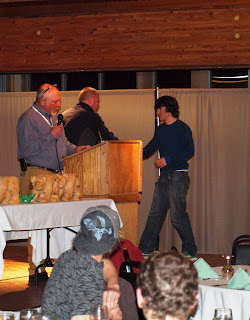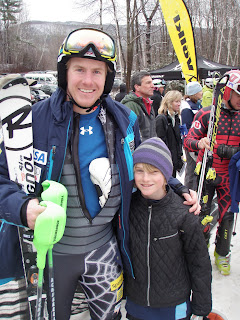
Having been intrigued by
Sugarloaf for years I ventured to this Northern resort this past early March. It was the right time to visit. A sizable storm had coated the East Coast covering this mountain with high quality snow.
The upper fields maintain a consistent steep pitch (Eastern US standards) for a good portion of the 2820 feet of vertical. The summit (where I stand on photo below) sits at 4237 ft (a more impressive number than the equivalent 1291 m, a low elevation by many standards).
In fact, the pitch, the low traffic and the new snow manicured by two days of wind, provided excellent skiing, Western style. Add three consecutive days of delightful sunshine and the perfect skier-days unraveled.

(a view of the back snowfields from the top of Sugarloaf)
But in reality, I did not drive to Maine for a weekend getaway. I was attending the Junior Olympics or J2 National Championships, an event gathering top skiers representing the three US ski regions: West, East and Rocky Central (well a few foreigners raced too).

Managed with excellence from the very first race (a soft snow SL on a warm day), this event showed the perfect balance of camaraderie, professionalism and dedication.
The SuperG
phenomenal snow surface, revealing careful care and preparation of slope for some time, topped with superior grooming.
Good combination A and B netting providing a very safe triple fence at key points of the course (picture of lower section taken below headwall)
Approaching the speed trap @ 70 mph

Skiing the flats, carrying speed from the head wall





After finishing two events...


An award in
Slalom

And a happy Thomas and Miles
After the race was over... I managed to sneak into the perfectly groomed hill and feel the speed, once again (it had been a few years). It was the best experience of the winter thanks to great gear, properly tuned edges and I must admit, fairly good conditioning (for which I can take credit)


















































